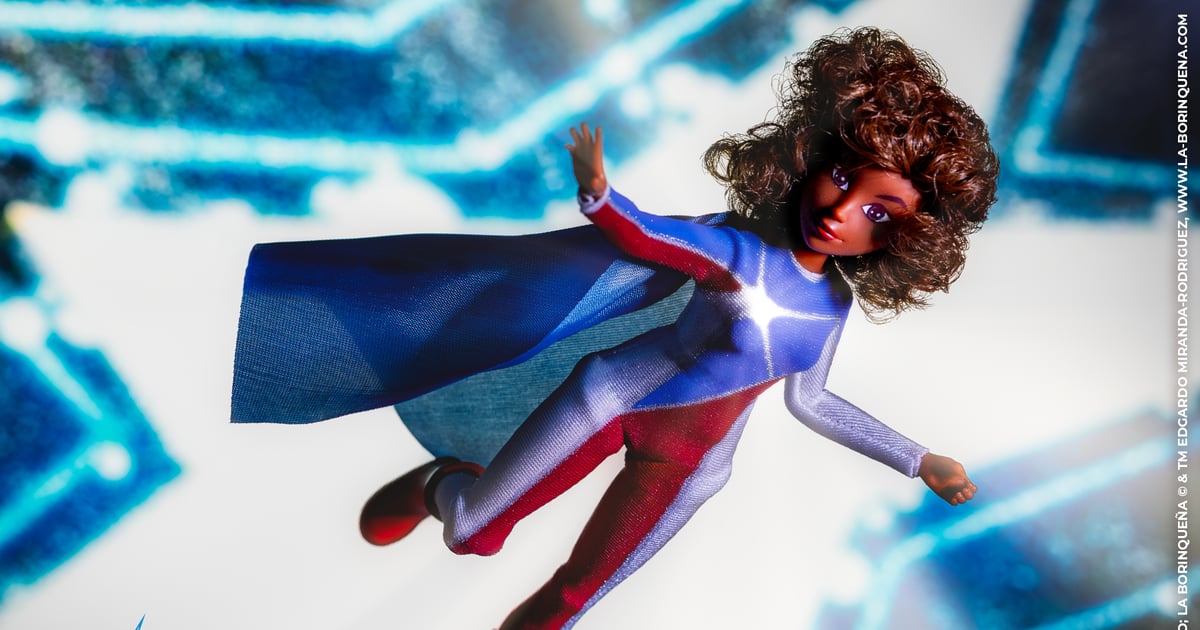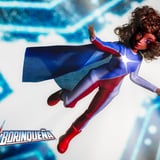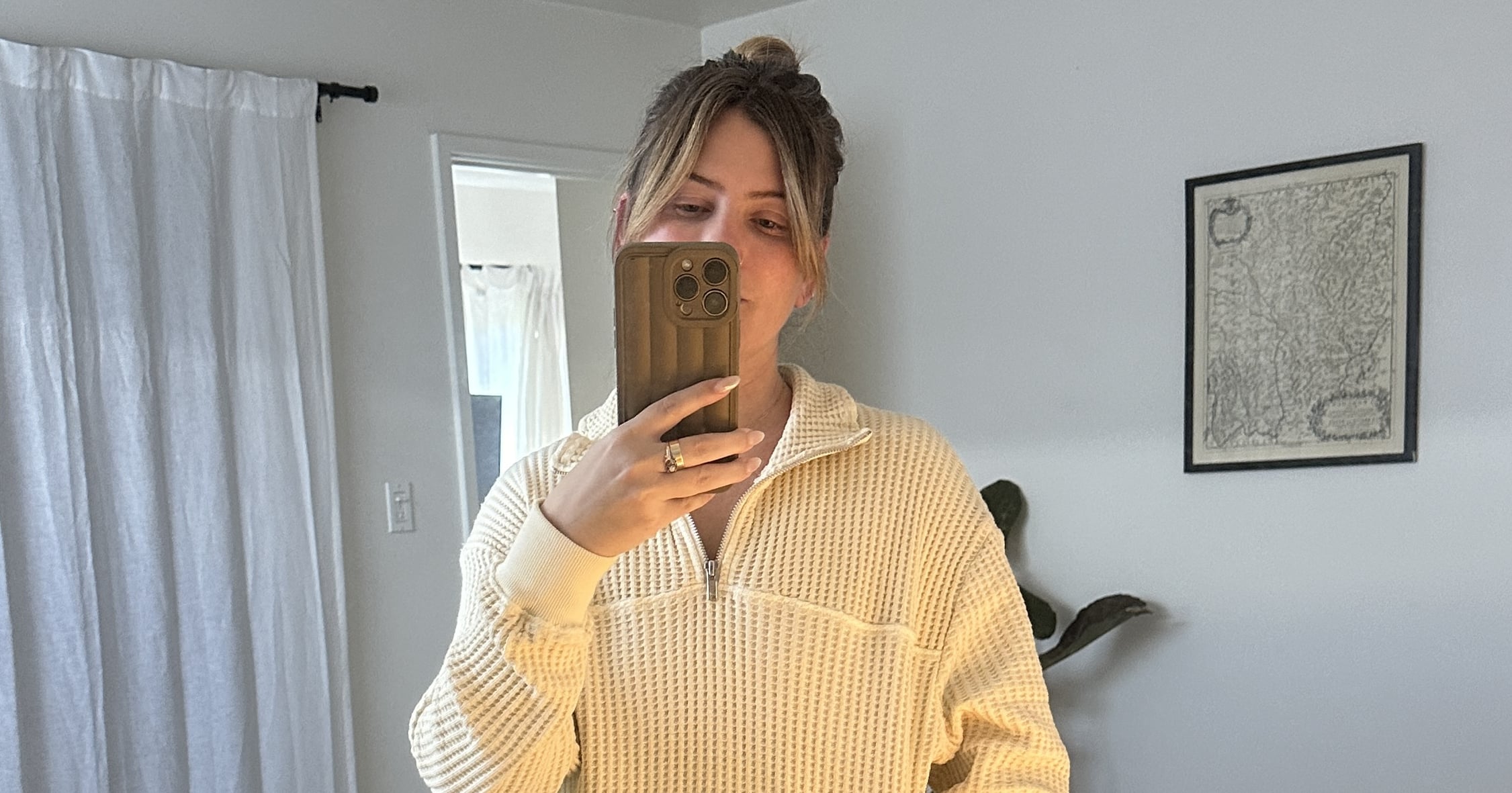Edgardo Miranda-Rodriguez still feels the pressure of being a one-man army when it comes to promoting the crown jewel of Somos Arte, his independent creative studio. Since 2016 he’s been at the forefront of every campaign surrounding his creation La Borinqueña. The Puerto Rican superheroine has been the star of a series of self-titled graphic novels that have directly tackled cultural topics and current events at the forefront of the island, all through the lens of a superhero yarn. It’s an effort that’s earned him a humanitarian award at the 2019 Eisner Awards (the comics industry’s Academy Awards), collaborations with Hollywood stars such as Rosario Dawson, and crossovers with DC Comics’s biggest characters like Wonder Woman. But even with all the accolades, he makes it clear, it’s always been an uphill battle.
“There’s so many moving pieces when you’re something as big as the Marvel Cinematic Universe, when you’re something as big as Star Wars,” Miranda-Rodriguez tells POPSUGAR. “But [how about] when you’re something as tiny as a freaking sorullito called La Borinqueña? You have me, and I literally feel like your abuela in the kitchen doing a gazillion things at the same time. I’m making the bacalaitos while I’m tending to the rice, while I’m checking on the habichuelas, while I’m flipping over tostones, all while I’m carving up the pernil.”
But even while acknowledging the workload, Miranda-Rodriguez sees it as a responsibility he happily carries. Last year, on the fifth anniversary of the devastating passage of Hurricane María over Puerto Rico, he released a special edition of “La Borinqueña” with a commemorative cover. The funds from those sales went to various philanthropic organizations that Somos Arte supports, most of them grassroots organizations involved in helping causes relevant to Puerto Rico and its diaspora population.
Recently, he concocted and put into effect his newest expansion of the Borinqueña brand: action figures, with multiple points of articulation in order to make them posable. While still eminently popular with children, action figures – especially those of pop culture characters – have become a large market for collectors and enthusiasts. Having introduced a brand-new superhero team called the Nitaínos in the latest installment of “La Borinqueña,” he now had a roster of characters to pull from to fill out fans’ shelves.
Ever cognizant of his community’s needs, Miranda-Rodriguez decided to go further. He teamed up with the same company that manufactured the action figures, Boss Fight Studios, to release a doll based on La Borinqueña, available for preorder on their website.
“They’re doing something they’ve never done before. They’re actually making toys for children, and they created a line of dolls for girls called I Am Brilliance,” he says. “The first wave of these dolls actually have two luchadoras from the Masked Republic, which is a wrestling franchise that exists. But La Borinqueña is actually part of that wave as well, which is separate from las luchadoras.”
Miranda-Rodriguez has studied the sociopolitical structure of race and ethnicity and its impact on Black and brown communities, and he has always had an eye for considering them with all his projects. In this case, the doll will reflect La Borinqueña’s identity as a Black Latina, from the color of her skin to her curly hair. This is done with intent.
“This has a lot to do with how young girls, especially, are conditioned through play,” he explains. “Conditioning in terms of the roles they play, the gender roles they play, the class roles they play, and even the roles they play in identifying themselves racially.”
A big inspiration for his impetus to make the Borinqueña doll is a now-infamous experiment carried out in 1939 known as the Clark doll test, named after the psychologists who carried it out.
“The Clark experiment pretty much cemented the idea that many [African-American] children had an internalized self-hatred of their own complexion – of their own identity,” Miranda-Rodriguez says. “And when they were given the choice to choose between a white baby doll and a Black baby doll, they played with the white doll. And when they weren’t allowed to play with the white doll and were only given a chance to play with the Black doll, they were very upset.”
This is the level of care and attention to detail Miranda-Rodriguez imbues his stories with as well, always looking for a way to intersect the escapism of comic books with a conscious finger on the pulse of what real-world topics need to be highlighted.
“Introducing this character to a child, particularly little girls, to me is revolutionary because I’m giving [them] a choice between ‘Do you want to play with the baby doll or the fashion doll?’ [or] ‘Do you want to actually play with the superhero?'” he says. “The superhero that looks like you, the superhero that actually speaks to your heritage, the superhero that has your hair color, your mother’s hair texture, [and] your skin color. A superhero that actually comes from a real place. A superhero that affirms their identity, that affirms their place and affirms their visibility.”
Representation and inclusiveness is a topic he’s fastidiously touched on before in the “La Borinqueña” series and arguably serves as the thematic throughline for it as a whole.
The goal, he expresses, is to address not only the internalized racism that the Clark test demonstrated but also an “internalized colonialism” that he surmises exists within some Puerto Ricans as well. The country once banned its own flag and demonized its nationalist heroes, and that has led to what he says is the painful effect that some “don’t see the value in our heritage, we don’t see the value in our heroes.” Adorning La Borinqueña in the Puerto Rican colors is a way to counteract that.
The hope for Miranda-Rodriguez and Boss Fight Studios is to have the dolls ready for sale by Día de los Reyes – January. It’s an important holiday in Latin America, particularly in Puerto Rico, which is known for its extended Christmas holiday season. The doll will be distributed online and available in certain stores across the East Coast.
“Our hope is that we’re entering into a space that’s dominated by multibillion-dollar corporations so that big stores like Walmart or Target see the value of La Borinqueña action figures [and] La Borinqueña dolls and put them on the shelves,” Miranda-Rodriguez says.
The endeavor was preceded by a successful campaign with Puerto Rican cocoa processor Chocolate Cortés, which sold limited-edition chocolate bars with La Borinqueña comic strips printed on the wrappers. The run exhausted the Puerto Rico inventory and forced Chocolate Cortés to tap into its Florida-based distribution point. It validated Miranda-Rodriguez’s long-held aspiration to work with and support local businesses,
As always, he and his team at Somos Arte (which includes his wife, Kyung Jeon-Miranda, as projects director) will continue to push forward with bigger plans for their works and strive to get them in front of new audiences.
“There is a necessity for us as Latin people to see the value in our own intellectual properties, and our own art, and our own stories,” he says. “So that we can show the rest of the world that our stories, our characters, and our toys need to be on the same shelves as other heroes as well.”



